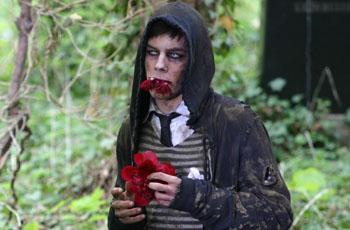
Otto: or, Up with Dead People (Movie Review)
“The dead look so terribly dead when they're dead” is the epitaph, quoted from W. Somerset Maugham's novel The Razor's Edge, for “Otto; or, up with dead people.” A strangely obscure quote to begin a film with, but relevant in the fact that it explains a lot about the film you are about to watch. It's cheeky, offbeat, and altogether reaching for a higher level of intelligence than what is presented.
I'll admit, I have never been a fan of zombie films. The first zombie film I actually enjoyed was "28 Days Later", which of course can be argued is more a film about biological warfare than zombies, but anyway, I thought choosing “Otto; or, up With Dead People” would be a far enough departure from zombie films that I would find something fresh and different; and I can say that on that front I succeeded.
“Otto; or, up With Dead People” is a low budget German film written and directed by an underground Canadian porn star, Bruce LaBruce. Using the zombie film as a frame for homosexuality, LaBruce tells the story of Otto (Jey Crisfar) a homosexual zombie who rises from the dead one day. Meandering around through the countryside, dressed in emo-fabulous hoodie and jeans, eating roadkill and stumbling around, Otto has a lot of time to be existential with heavy overdubbing, discussing how “the living all seem like the same person to me and I don't think I like that person very much.”
Later, he runs into the self important socio-political lesbian filmmaker, Medea Yarn (Katharina Klewinghaus), who, seeing something special about Otto wants him to star in her new film entitled “Up With Dead People,” which is shot entirely in black and white and interspliced throughout the film. It takes place in a post apocalyptic zombie world where zombies are socially acceptable and have high motor skills, because the practice of embalming is no longer used.
Medea sees a direct correlation between society's reaction to homosexuals and zombies. In reality and unbeknownst to Medea, Otto is a zombie in a world that thinks he is pretending to be a zombie. Throughout the film, like a sufferer of amnesia, Otto has flashbacks of a previous boyfriend. Otto spends most of the film trying to piece together his memories and find out what happened to his previous lover, while Medea and others use him to forward their own agendas. Otto meets a few men along the way too, and literally tears them apart in a few graphic scenes where eating entrails is a form of foreplay. There is also another scene where a man penetrates a wound in another man's stomach.
“Otto” uses zombies as a springboard into a discussion of social and sexual politics. In Romero's world of zombies, zombies are a metaphor for mindless capitalism, here the metaphor is reversed and human beings are the conformists, while zombies like Otto are the marginalized forward thinking nonconformists.
The film is interesting in that it is a complete departure from the typical zombie storyline, but it also marginalizes a horror audience because it is so heavy with social commentary. The character of Medea, while humorous in her overt opinion on homosexuality and zombies, becomes less humorous the more she appears on screen, seemingly delivering a conference on her films, while footage of airplanes dropping bombs and monks setting themselves on fire play on a screen behind her. Medea also has a girlfriend who appears as a black and white film star, her dialog appearing in separate intertitles, but it is uncertain why exactly she appears this way besides that the fact it looks kind of neat on screen.
Let me make a bold statement here. I only recommend this film to those familiar with LaBruce's work or those who are comfortable watching male on male penetration. This leans more towards the indie art house style than the horror genre and may take a few viewers by surprise if they are looking for a straight up horror film (no pun intended). Instead, “Otto” would much rather ramble on clumsily at an hour and thirty minutes about so many topics, that by the end of the film you will be confused as to what the real argument LaBruce is trying to make about society's relationship to homosexuality. Also, did I mention the tag line? “He's bringing sexy back... from the dead.”
I'm also uncertain as to why exactly the film had to be made in Germany. LaBruce utilizes the German countryside and cities well, but does the film actually need to reach a higher level of avantgarde by being spoken in German? Perhaps it is because Germans and Europeans are more accepting of the sexually forward thinking, but still, the reasoning does not seem completely thought through.
LaBruce's cameraworks feels like he just graduated from filmschool, despite this being his twelfth film. Also, the version I watched was dubbed which was extremely annoying, and the dubbing lagged a full scene behind. I don't know if it was the particular dvd I had or if it was some sort of art house technique to make me feel even more disconnected to this film. Either way, it certainly didn't help matters.

